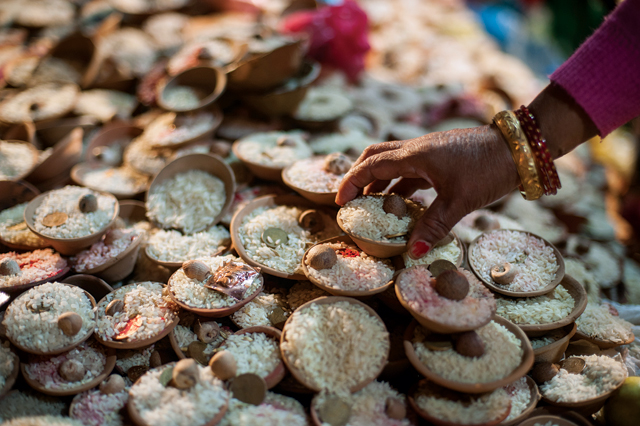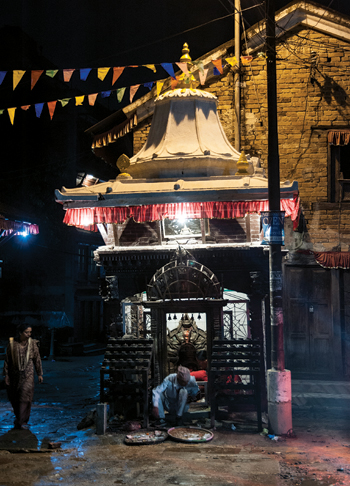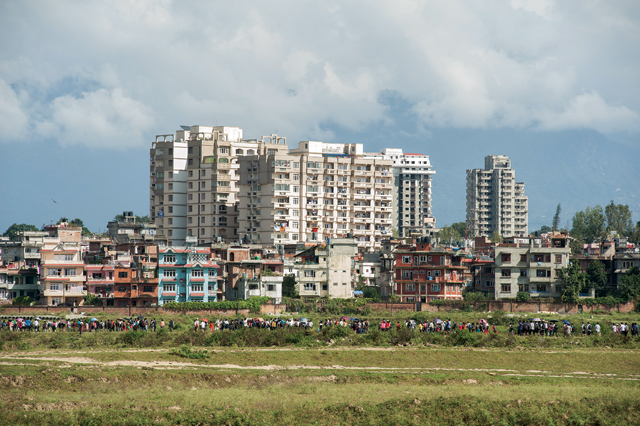All true great thoughts are conceived while walking. - Friedrich Nietzsche
Are you sure you can do this?” she asked me. I said I was doing the walk.
The story is dated back to Dipankha Yuga,when an avaatar of the Buddha was born as a blue-horned bull. This bull was stolen from Patan’s Nagbahal. The blue color was associated with the prosperity of Nagbahal’s people. The pilgrimage was about looking for the bull, which included visiting to 131 temples on the way. This was the story my 94-year-old grandmother told me, a smile spreading on her deeply wrinkled face. She was remembering how she had fallen asleep and bumped her head into the person walking in front of her, while walking under a deep blue night sky near Pashupatinath.

She was happy that she had completed the walk when she had the time and all the energy she needed. Her content smile and her experience proved to be a motivating factor, as I decided on joining the Dipankha Yatra. I have to also mention here that walking is something I love. I did not want to not let go of this opportunity; it combined something I loved with earning great karma.
 At half past three in the morning, Patan was teeming with crowds of pilgrims who had already started walking. The place was lit up and the excitement was tangible. Looking around, I was happy to see a lot of people of my age. These youngsters had similar reasons as mine for the walk; it would be kilometers to cover, new alleys to explore, and plenty of stories to share with friends for weeks afterwards. As my mind filled with such ideas, I overheard a mother tell her son that her grandmother too had completed this search for the bull at his age. Thinking of my own grandmother, it added resolve to my plans.
At half past three in the morning, Patan was teeming with crowds of pilgrims who had already started walking. The place was lit up and the excitement was tangible. Looking around, I was happy to see a lot of people of my age. These youngsters had similar reasons as mine for the walk; it would be kilometers to cover, new alleys to explore, and plenty of stories to share with friends for weeks afterwards. As my mind filled with such ideas, I overheard a mother tell her son that her grandmother too had completed this search for the bull at his age. Thinking of my own grandmother, it added resolve to my plans.
It had rained the day before and the roads in Bungamati were all slippery; this did not make it easy for the walkers. Everyone in the crowd held onto each other’s hands, shouting to the people following them to be careful of each step. Every now and then someone would crack a joke and make everyone in the walk laugh. This was the group I would be more or less traveling with all day. Its always easy making conservation when everyone is on the same page.
Reaching Bungmati, home to the Rato Matsyendranath, offered me a different picture of religion-affinity. At the doorsteps of every home, people waited serving drinking water, black tea and biscuits and even offering toilet facilities for the yatris. The hospitality and the welcoming faces were overwhelming. Young children asking you if they could help with anything was something I certainly wasn’t expecting. This was the case with every yatri for the entire day. People who could not do the walk thanked you for doing this dharma on behalf of them. Their hospitality, their strong belief and their expectations from the walk to bring prosperity and religious harmony to all, motivated one to carry on ahead with added vigor.

This affinity wasn’t limited to the people of Bungmati. It was literally everywhere the trail led. Hot water for sore feet, ice blocks to ease your blisters, power strips to charge your mobile phones, candy, basic medicine; throughout the day, everything you could possible need was just a step away. It was a day when everything you needed was given to you for free; it was a day devoted to compassion towards one’s beliefs.

Walking towards Ichhangunarayan made me think of the emerging urbanization. The greenery around this area surprised me. I sat down to catch my breath by the roadside and saw two images. One was of people walking in groups helping each other and motivating each other to ‘find this lost bull’ – this depicted our strong bond of culture. On the other hand I saw homes isolated from the city, away from societies, depicting a growing sense of urbanization. This part of the walk had me internalizing a sense of diversity among us. The view while coming down from Ichhangunarayan, an ocean of buildings,was a reality check for many about the capital’s state. I was glad to hear a passerby comment that the hardest part of the walk was over.
A definite highlight of the trip? Locals using a water pump to spray cool water onto yatris walking in the harsh midday sun. It was true bliss if I’ve ever known it. The water spray and the cool wind atop Swoyambhu’s hill. Coming down those long stairs will stay with me for long. Climbing down each step, the weight of my body challenging me knees and my blister-sore feet will be the story I tell my children and my grandchildren even.
Every yatri seemed to take a long deep breath before heading down the hill, grimacing with pain at each stone step. At the bottom of the hill, I sat down again, looking at my shoes, when a kind, elderly voice said, “You will be able to do this, you will feel tired but this is dharma karma, all this pain will come back to you and your family in different forms of prosperity like the bull did.” I could not reply to her, but I gave her a grateful smile. It was as if she had read my ideas about giving up, getting on a taxi and going home.

I looked at her feet. She was wearing plastic slippers, covered with mud. That was the last I saw of her after we rested for 10 minutes. I should have easily seen her again, but I didn’t. Call it religion, call it a walk, with slippers or comfortable running shoes, with whatever motive you started with, at the end it’s all about believing and not suspending our selves from all kinds of complicated life events.
Every pile of stones or a wall to lean on felt as comfortable as my bed. My legs had quit and I felt ever blister on my sole. Getting home and resting my feet consumed my mind. I wondered how people were continuing to walk for so long. With wobbly legs, I stood up again and walked slowly. I got a tap on my shoulder from a lady asking me, “Are you going to make it to Bouddha? I cannot walk anymore, do you mind taking my offerings with you?” I cupped my hands and took what she gave me; one more reason to make it to the end. The two incidents stuck to my mind. One seemed to tell me that god is looking after us at every step, to have some faith and believe in karma, which gave me a new way of looking at things we worry about every day. Two, a woman I did not know had just handed over her karma to me. I walked with tired body but strengthened soul.
The empty roads turned golden with the streetlights and everyone’s pace slowed. Pain and exhaustion was on everyone’s faces. Each temple had a person welcoming us, congratulating us on making it this far and letting us know which place was next and what was being offered for the yatris to eat and to keep on walking.
After a long walk trailing the long walls of the Hyatt Hotel, I started hearing music and the Bouddha stupa came into view. More than anything else, I saw a place to rest, to stretch and to get some sleep. All I remember is staring at the stupa and placing there the offering I had received from the woman. I had walked for more than 18 hours.
I woke up with the feeling of falling down only to realize that my head had landed on the floor. It was four in the morning. This meant we had to start walking again and make it back home. I put on my shoes and got up. It felt like there were not mine, my feet did not feel comfortable inside it. I knew exactly which part of my toes hurt. That one moment of standing in my shoes was telling me the story of the distance I had walked.
It was as if my mind and body were not on good terms with each other that morning. Dragging my feet, we reached the forest inside the Pashupatinath where the blue horn bull was assumed to be left after being stolen. The journey started from Nagbahal Patan from a Buddhist temple and ended in the Pashupatinath Temple one of the most famous pilgrimage site of Hinduism, which shows the religious harmony being maintained by the bull if I may say so. The thief stole the bull and bought it in the forest for some reason, maybe for a benefit but after walking for it, I realized that it was a blessing in disguise. This brought people together in this festival of walking and indulged a perception of religion being an act of faith, affinity, hospitality and more over an act through a clean heart.
Our journey ended and it ended in Lagankhel, which was nothing less than a graduation ceremony. The only difference was the three steps up and down to put tika on the stage, in my graduation were not that painful.
A bull in everybody found their way back home, delighted, changed, thankful and well explored through the valley and through the people’s heart full of love and respect for the faith/religion we carry on our self. With this different form of norms, we follow to keep it alive for the contemporary era to witness it. I do not know about the bull but I found my way back home with great positive judgment and perception that has surely brought changes in my individuality.











